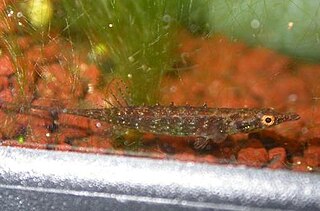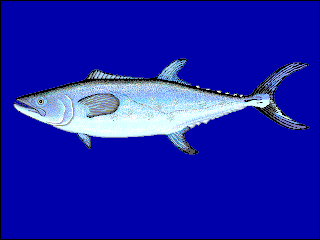
Synbranchiformes, often called swamp eels, though that name can also refer specifically to Synbranchidae, is an order of ray-finned fishes that are eel-like but have spiny rays, indicating that they belong to the superorder Acanthopterygii.
The Mastacembelidae are a family of fishes, known as the spiny eels. The Mastacembelids are part of the Order Synbranchiformes, the swamp eels, which are part of the Actinopterygii.

Stenodus leucichthys is a species of freshwater whitefish in the family Salmonidae. In the strict sense its natural distribution is restricted to the Caspian Sea basin. It is now considered extinct in the wild, but survives in cultured stocks. The nelma, a more widespread species of Eurasian and North America, is sometimes considered its subspecies.
The Chinese sturgeon is a critically endangered member of the family Acipenseridae in the order Acipenseriformes. Historically, this anadromous fish was found in China, Japan, and the Korean Peninsula, but it has been extirpated from most regions due to habitat loss and overfishing.
Mastacembelus is a genus of many species of spiny eel fish from the family Mastacembelidae. They are native to Africa and Asia. Most are found in rivers and associated systems, but there are also species in other freshwater habitats and a particularly rich radiation is found in the Lake Tanganyika basin with 15 species. A few species can even occur in brackish water.
Macrognathus is a genus of eel-like fish of the family Mastacembelidae of the order Synbranchiformes.

Mastacembelus cunningtoni is a species of fish in the family Mastacembelidae. It is endemic to the Lake Tanganyika basin, including the Lakes outflow, the Lukuga River as far as the Kisimba-Kilia rapids. It occurs in Burundi, the Democratic Republic of the Congo, Tanzania, and Zambia. The specific name of this fish honours the British zoologist and anthropologist William Alfred Cunnington (1877-1958), leader of the expedition to Lake Tanganyika which collected the type.

Mastacembelus moorii is a species of fish in the family Mastacembelidae. It is endemic to Lake Tanganyika where it is a secretive species hiding among rocks or in the sediment in the littoral zone. It grows to a total length of 44 centimetres (17 in). The specific name honours the leader of an expedition to Lake Tanganyika, the biologist John Edmund Sharrock Moore (1870-1947).

Mastacembelus platysoma is a species of fish, a spiny eel in the family Mastacembelidae. It is found in Lake Tanganyika which is bordered by Burundi, the Democratic Republic of the Congo, Tanzania and Zambia. The IUCN has listed it as being of "Least Concern".

The Liberian swamp eel is a species of fish in the family Synbranchidae. It is indigenous to Liberia. It has also been found in Sierra Leone, with an unconfirmed report from Côte d'Ivoire. It was first described by Jacques Pellegrin in 1922 as Typhlosynbranchus boueti, but was later moved to Monopterus. However, a 2020 study revived Typhlosynbranchus. Due to the deficiency in data, the species has not been classified with respect to endangerment.

Eels are ray-finned fish belonging to the order Anguilliformes, which consists of eight suborders, 20 families, 164 genera, and about 1000 species. Eels undergo considerable development from the early larval stage to the eventual adult stage and are usually predators.

Inimicus is a genus of marine ray-finned fishes, it is one of two genera in the tribe Choridactylini, one of the three tribes which are classified within the subfamily Synanceiinae within the family Scorpaenidae, the scorpionfishes and their relatives. These venomous, benthic fishes are found on sandy or silty substrates of lagoon and seaward reefs, in coastal regions of tropical oceans. The ten described species are collectively known by various common names, including ghoul, goblinfish, sea goblin, spiny devilfish, stinger, and stingfish.

Indostomus is a genus of small fishes native to slow moving or stagnant freshwater habitats in Indochina. It is the sole genus of the monogeneric family Indostomidae, Long considered to be sticklebacks, within the order Gasterosteiformes, modern analyses place the Indostomids within the order Synbranchiformes, related to the spiny eels and swamp eels.

The Chinese mackerel, also known as the Chinese seerfish, is a ray-finned bony fish in the family Scombridae, better known as the mackerel family. More specifically, this fish is a member of the tribe Scomberomorini, the Spanish mackerels. It is a marine species occurring in the Western Pacific Ocean, but it also enters the Mekong River.
Tor sinensis, the Chinese or Red mahseer is a species of mahseer native to the Mekong River. It is known with certainty only from Yunnan, China; reports from Cambodia, Laos, and Thailand require confirmation.
It is one of four currently valid species described from China, the others being Tor laterivittatus, Tor polylepis, and Tor yingjiangensis.
Ophichthys desilvai is a commercially important, air-breathing species of fish in the family Synbranchidae. It is endemic to Sri Lanka and is the only endemic synbranchid from there.
Macrognathus zebrinus, the zebra spiny eel, is a species of spiny eel endemic to Myanmar, specifically known from the Irrawaddy River, Sittaung River and Salween River and may also occur in Indonesia. It was originally described as Mastacembelus zebrinus before being moved to the genus Macrognathus in 1984 and 1986.
Vinagarra is a genus of ray-finned fish in the family Cyprinidae endemic to Vietnam.

Ophichthys is a genus of swamp eels native to South Asia. They live in freshwater or subterranean habitats, and some have a fossorial lifestyle.












